汽车行驶记录仪及数据分析软件的设计的开题报告
- 格式:docx
- 大小:11.15 KB
- 文档页数:3
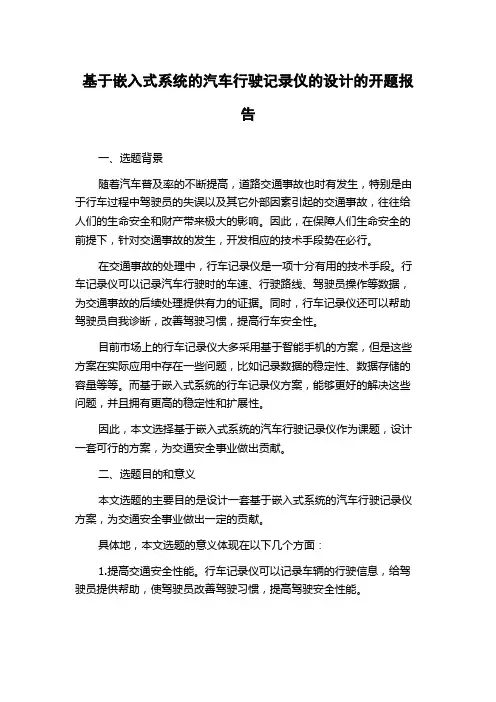
基于嵌入式系统的汽车行驶记录仪的设计的开题报告一、选题背景随着汽车普及率的不断提高,道路交通事故也时有发生,特别是由于行车过程中驾驶员的失误以及其它外部因素引起的交通事故,往往给人们的生命安全和财产带来极大的影响。
因此,在保障人们生命安全的前提下,针对交通事故的发生,开发相应的技术手段势在必行。
在交通事故的处理中,行车记录仪是一项十分有用的技术手段。
行车记录仪可以记录汽车行驶时的车速、行驶路线、驾驶员操作等数据,为交通事故的后续处理提供有力的证据。
同时,行车记录仪还可以帮助驾驶员自我诊断,改善驾驶习惯,提高行车安全性。
目前市场上的行车记录仪大多采用基于智能手机的方案,但是这些方案在实际应用中存在一些问题,比如记录数据的稳定性、数据存储的容量等等。
而基于嵌入式系统的行车记录仪方案,能够更好的解决这些问题,并且拥有更高的稳定性和扩展性。
因此,本文选择基于嵌入式系统的汽车行驶记录仪作为课题,设计一套可行的方案,为交通安全事业做出贡献。
二、选题目的和意义本文选题的主要目的是设计一套基于嵌入式系统的汽车行驶记录仪方案,为交通安全事业做出一定的贡献。
具体地,本文选题的意义体现在以下几个方面:1.提高交通安全性能。
行车记录仪可以记录车辆的行驶信息,给驾驶员提供帮助,使驾驶员改善驾驶习惯,提高驾驶安全性能。
2.提高交通事故的处理效率。
行车记录仪可以提供事故发生时的相关数据,使交通事故处理更加公正和准确。
3.促进嵌入式技术的应用。
嵌入式技术可以提高系统稳定性和扩展性,为行车记录仪的应用提供有力保证。
三、研究内容和方法本文主要研究内容包括:1.嵌入式系统的相关技术和应用。
包括嵌入式系统的构成和原理,常见的嵌入式系统平台(如STM32),以及嵌入式系统的应用。
2.汽车行驶记录仪的相关技术和应用。
包括行车记录仪的原理,行车记录仪的功能要求(如GPS定位、视频录制等),以及行车记录仪的软件实现等。
3.基于嵌入式系统的汽车行驶记录仪的方案设计。
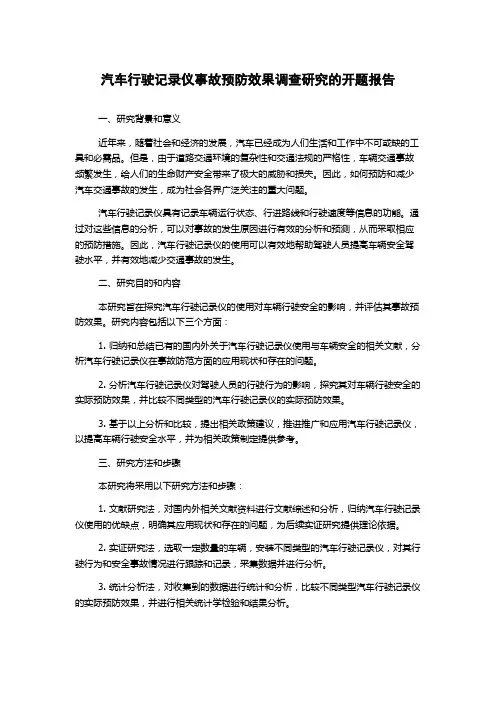
汽车行驶记录仪事故预防效果调查研究的开题报告一、研究背景和意义近年来,随着社会和经济的发展,汽车已经成为人们生活和工作中不可或缺的工具和必需品。
但是,由于道路交通环境的复杂性和交通法规的严格性,车辆交通事故频繁发生,给人们的生命财产安全带来了极大的威胁和损失。
因此,如何预防和减少汽车交通事故的发生,成为社会各界广泛关注的重大问题。
汽车行驶记录仪具有记录车辆运行状态、行进路线和行驶速度等信息的功能。
通过对这些信息的分析,可以对事故的发生原因进行有效的分析和预测,从而采取相应的预防措施。
因此,汽车行驶记录仪的使用可以有效地帮助驾驶人员提高车辆安全驾驶水平,并有效地减少交通事故的发生。
二、研究目的和内容本研究旨在探究汽车行驶记录仪的使用对车辆行驶安全的影响,并评估其事故预防效果。
研究内容包括以下三个方面:1. 归纳和总结已有的国内外关于汽车行驶记录仪使用与车辆安全的相关文献,分析汽车行驶记录仪在事故防范方面的应用现状和存在的问题。
2. 分析汽车行驶记录仪对驾驶人员的行驶行为的影响,探究其对车辆行驶安全的实际预防效果,并比较不同类型的汽车行驶记录仪的实际预防效果。
3. 基于以上分析和比较,提出相关政策建议,推进推广和应用汽车行驶记录仪,以提高车辆行驶安全水平,并为相关政策制定提供参考。
三、研究方法和步骤本研究将采用以下研究方法和步骤:1. 文献研究法,对国内外相关文献资料进行文献综述和分析,归纳汽车行驶记录仪使用的优缺点,明确其应用现状和存在的问题,为后续实证研究提供理论依据。
2. 实证研究法,选取一定数量的车辆,安装不同类型的汽车行驶记录仪,对其行驶行为和安全事故情况进行跟踪和记录,采集数据并进行分析。
3. 统计分析法,对收集到的数据进行统计和分析,比较不同类型汽车行驶记录仪的实际预防效果,并进行相关统计学检验和结果分析。
4. 政策建议法,在总结和分析研究结果的基础上,提出相关政策建议,推行推广和应用汽车行驶记录仪,提高车辆行驶安全水平。
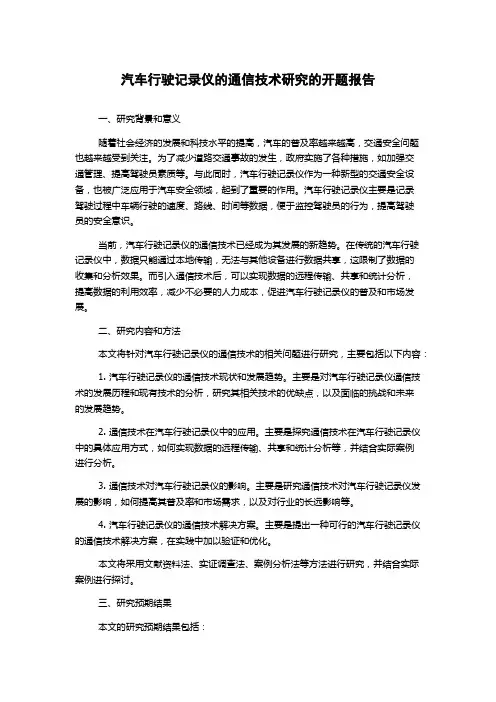
汽车行驶记录仪的通信技术研究的开题报告一、研究背景和意义随着社会经济的发展和科技水平的提高,汽车的普及率越来越高,交通安全问题也越来越受到关注。
为了减少道路交通事故的发生,政府实施了各种措施,如加强交通管理、提高驾驶员素质等。
与此同时,汽车行驶记录仪作为一种新型的交通安全设备,也被广泛应用于汽车安全领域,起到了重要的作用。
汽车行驶记录仪主要是记录驾驶过程中车辆行驶的速度、路线、时间等数据,便于监控驾驶员的行为,提高驾驶员的安全意识。
当前,汽车行驶记录仪的通信技术已经成为其发展的新趋势。
在传统的汽车行驶记录仪中,数据只能通过本地传输,无法与其他设备进行数据共享,这限制了数据的收集和分析效果。
而引入通信技术后,可以实现数据的远程传输、共享和统计分析,提高数据的利用效率,减少不必要的人力成本,促进汽车行驶记录仪的普及和市场发展。
二、研究内容和方法本文将针对汽车行驶记录仪的通信技术的相关问题进行研究,主要包括以下内容:1. 汽车行驶记录仪的通信技术现状和发展趋势。
主要是对汽车行驶记录仪通信技术的发展历程和现有技术的分析,研究其相关技术的优缺点,以及面临的挑战和未来的发展趋势。
2. 通信技术在汽车行驶记录仪中的应用。
主要是探究通信技术在汽车行驶记录仪中的具体应用方式,如何实现数据的远程传输、共享和统计分析等,并结合实际案例进行分析。
3. 通信技术对汽车行驶记录仪的影响。
主要是研究通信技术对汽车行驶记录仪发展的影响,如何提高其普及率和市场需求,以及对行业的长远影响等。
4. 汽车行驶记录仪的通信技术解决方案。
主要是提出一种可行的汽车行驶记录仪的通信技术解决方案,在实践中加以验证和优化。
本文将采用文献资料法、实证调查法、案例分析法等方法进行研究,并结合实际案例进行探讨。
三、研究预期结果本文的研究预期结果包括:1. 对汽车行驶记录仪通信技术的发展历程、现状和未来发展趋势进行深入分析,可以为行业的发展提供一定的指导。
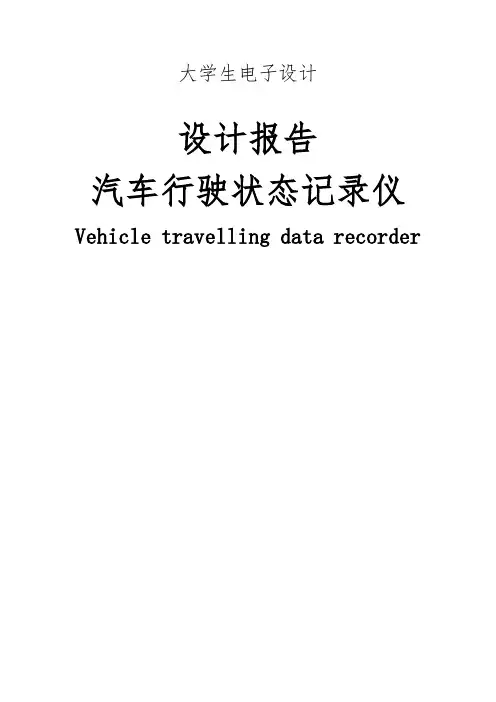
大学生电子设计设计报告汽车行驶状态记录仪Vehicle travelling data recorder目录摘要 (1)一、方案论 (2)1.1系统微处理器的个数选择 (2)1.2存储显示微处理器作为主控制的选择 (2)二、系统设计 (3)2.1系统基本功能 (3)2.2系统性能指标 (3)2.3系统的提升部分 (3)2.4硬件设计 (4)2.5软件设计 (5)2.6特殊元件介绍 (17)三、测试说明 (18)3.1测试工具 (18)3.2霍尔元件功能测试 (18)3.3软件调试 (18)3.4测试数据 (18)3.5调试过程中遇见的问题分析以及解决方案 (20)3.6系统功能参数 (21)3.7创新与特点 (21)四、结束语 (22)五、附录 (22)汽车行驶状态记录仪Vehicle travelling data recorder摘要:本项目名称为“汽车行驶状态记录仪”,系统微处理器采用双单片机,关键部件有GPS模块、温度传感器和霍尔元件等,用于提取有效信息对汽车行驶位置进行精确定位,并获取轨迹、速度、温度等信息,然后进行存储,以供用户查询汽车一个星期的行驶路径(注:考虑成本问题,样机记录时间长度为6天;如果作为产品,可以记录1个月甚至一年以上,根据用户的要求而定)。
本设计采用数字化电路,软件采用C语言,有利于对数据进行准确分析,减少干扰。
系统电路采用模块化的设计思想,由5个模块组成,分别为GPS接收模块、数据处理分析模块、存储模块、键盘处理模块和显示模块。
其中显示模块可采用LCD显示,还可提供通过串口与PC通信,然后在电子地图上将汽车轨迹形象地显示出来。
关键字:单片机;GPS模块;温度传感器;霍尔元件;LCD;PC地图Abstract: With the theme of automobile electron, the 2008 GuangdongUniversities Students Electron Design Contest aims at perfecting functionof the automobile by designing the electric circuits. And our design projectis the automobile travel condition recording instrument. This system adopts the microprocessor (MCU) to analyze the GPS module,the temperature sensor and the Hall part position the automobile accurately,More over, it can gain and restore the data of temperature value and velocity for inquiry of the aut omobile’s week-long travelling route. Digital electric circuits are applied in all of this system, all the softwares are programmed in monolithic integrated circuit C language in order to analyze the data and orientate precisely, and reduce the disturbance (interference) and the error of the data due to the hardware electric circuit. There are five modules in the system circuit: GPS receive module, data processing analysis module, memory module, keyboard processing module and demonstration module. And demonstration module includes the LCD demonstration module and the PC electron map demonstration module in which the electronic map is connected with GPS through the serial port.Key words: MCU; GPS module; Temperature sensor; Hall part; LCD; PC map一、 方案论证1.1,系统微处理器的个数选择。
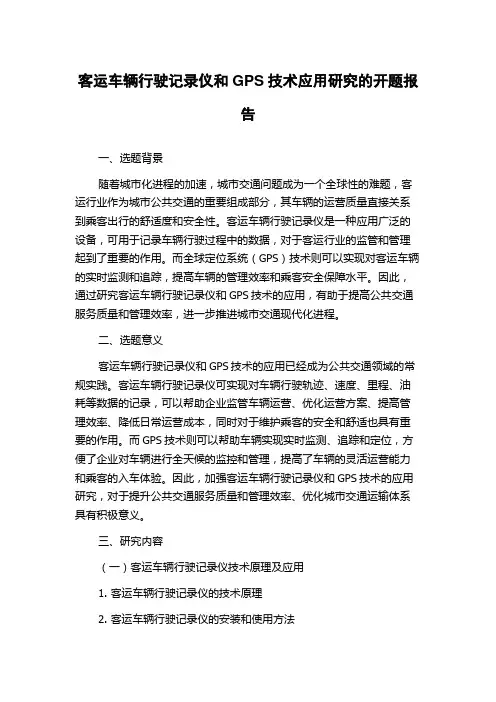
客运车辆行驶记录仪和GPS技术应用研究的开题报告一、选题背景随着城市化进程的加速,城市交通问题成为一个全球性的难题,客运行业作为城市公共交通的重要组成部分,其车辆的运营质量直接关系到乘客出行的舒适度和安全性。
客运车辆行驶记录仪是一种应用广泛的设备,可用于记录车辆行驶过程中的数据,对于客运行业的监管和管理起到了重要的作用。
而全球定位系统(GPS)技术则可以实现对客运车辆的实时监测和追踪,提高车辆的管理效率和乘客安全保障水平。
因此,通过研究客运车辆行驶记录仪和GPS技术的应用,有助于提高公共交通服务质量和管理效率,进一步推进城市交通现代化进程。
二、选题意义客运车辆行驶记录仪和GPS技术的应用已经成为公共交通领域的常规实践。
客运车辆行驶记录仪可实现对车辆行驶轨迹、速度、里程、油耗等数据的记录,可以帮助企业监管车辆运营、优化运营方案、提高管理效率、降低日常运营成本,同时对于维护乘客的安全和舒适也具有重要的作用。
而GPS技术则可以帮助车辆实现实时监测、追踪和定位,方便了企业对车辆进行全天候的监控和管理,提高了车辆的灵活运营能力和乘客的入车体验。
因此,加强客运车辆行驶记录仪和GPS技术的应用研究,对于提升公共交通服务质量和管理效率、优化城市交通运输体系具有积极意义。
三、研究内容(一)客运车辆行驶记录仪技术原理及应用1. 客运车辆行驶记录仪的技术原理2. 客运车辆行驶记录仪的安装和使用方法3. 客运车辆行驶记录仪的数据管理和分析方法4. 客运车辆行驶记录仪在公共交通领域的应用案例分析(二)GPS技术原理及其在客运车辆中的应用1. GPS技术原理和发展历程2. GPS在客运车辆监测和追踪中的应用方法3. GPS在客运车辆运营管理中的应用案例分析(三)客运车辆行驶记录仪和GPS技术应用的协同优化模式1. 客运车辆行驶记录仪和GPS技术在车辆监管和管理中的配合模式2. 客运车辆行驶记录仪和GPS技术在优化运营方案和提高管理效率中的配合模式3. 客运车辆行驶记录仪和GPS技术在提高乘客舒适度和安全保障中的配合模式四、研究方法本研究主要采用文献研究、案例分析和现场调研等方法。
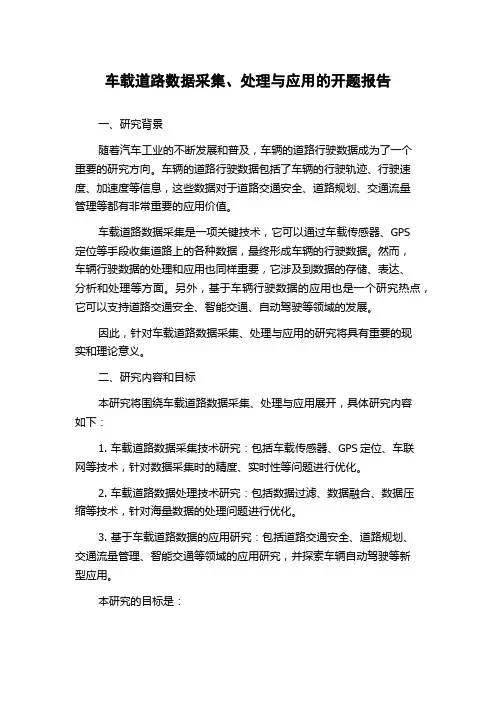
车载道路数据采集、处理与应用的开题报告一、研究背景随着汽车工业的不断发展和普及,车辆的道路行驶数据成为了一个重要的研究方向。
车辆的道路行驶数据包括了车辆的行驶轨迹、行驶速度、加速度等信息,这些数据对于道路交通安全、道路规划、交通流量管理等都有非常重要的应用价值。
车载道路数据采集是一项关键技术,它可以通过车载传感器、GPS定位等手段收集道路上的各种数据,最终形成车辆的行驶数据。
然而,车辆行驶数据的处理和应用也同样重要,它涉及到数据的存储、表达、分析和处理等方面。
另外,基于车辆行驶数据的应用也是一个研究热点,它可以支持道路交通安全、智能交通、自动驾驶等领域的发展。
因此,针对车载道路数据采集、处理与应用的研究将具有重要的现实和理论意义。
二、研究内容和目标本研究将围绕车载道路数据采集、处理与应用展开,具体研究内容如下:1. 车载道路数据采集技术研究:包括车载传感器、GPS定位、车联网等技术,针对数据采集时的精度、实时性等问题进行优化。
2. 车载道路数据处理技术研究:包括数据过滤、数据融合、数据压缩等技术,针对海量数据的处理问题进行优化。
3. 基于车载道路数据的应用研究:包括道路交通安全、道路规划、交通流量管理、智能交通等领域的应用研究,并探索车辆自动驾驶等新型应用。
本研究的目标是:1. 探究车载道路数据采集、处理与应用的关键技术,完善相关技术体系。
2. 建立车载道路数据处理的数据模型,实现对数据的有效表达和分析。
3. 探索基于车载道路数据的应用场景,并构建实际应用平台。
三、研究方法和步骤本研究将采用以下研究方法和步骤:1. 文献综述:对车载道路数据采集、处理与应用的研究现状进行综述,了解最新的研究成果和发展趋势。
2. 数据采集和处理:通过车载传感器、GPS定位、车联网等方式收集车辆的行驶数据,并采用数据过滤、融合和压缩等技术进行处理。
3. 数据分析和应用:基于车载道路数据建立数据模型,发现并分析数据中蕴含的信息,探索数据的应用场景,并构建相应的应用系统。
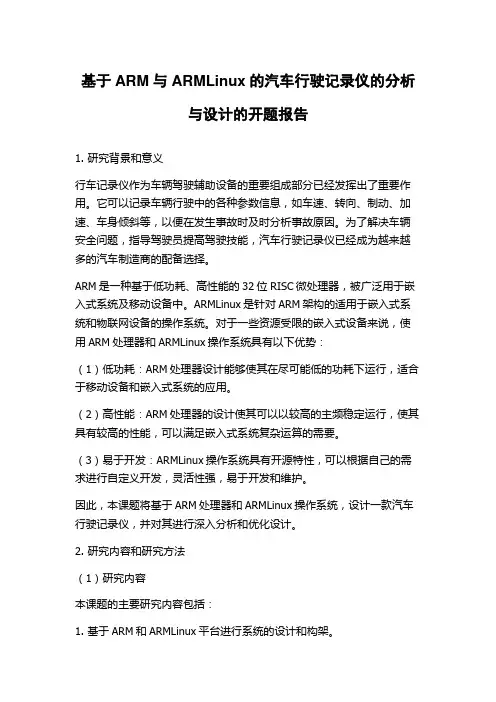
基于ARM与ARMLinux的汽车行驶记录仪的分析与设计的开题报告1. 研究背景和意义行车记录仪作为车辆驾驶辅助设备的重要组成部分已经发挥出了重要作用。
它可以记录车辆行驶中的各种参数信息,如车速、转向、制动、加速、车身倾斜等,以便在发生事故时及时分析事故原因。
为了解决车辆安全问题,指导驾驶员提高驾驶技能,汽车行驶记录仪已经成为越来越多的汽车制造商的配备选择。
ARM是一种基于低功耗、高性能的32位RISC微处理器,被广泛用于嵌入式系统及移动设备中。
ARMLinux是针对ARM架构的适用于嵌入式系统和物联网设备的操作系统。
对于一些资源受限的嵌入式设备来说,使用ARM处理器和ARMLinux操作系统具有以下优势:(1)低功耗:ARM处理器设计能够使其在尽可能低的功耗下运行,适合于移动设备和嵌入式系统的应用。
(2)高性能:ARM处理器的设计使其可以以较高的主频稳定运行,使其具有较高的性能,可以满足嵌入式系统复杂运算的需要。
(3)易于开发:ARMLinux操作系统具有开源特性,可以根据自己的需求进行自定义开发,灵活性强,易于开发和维护。
因此,本课题将基于ARM处理器和ARMLinux操作系统,设计一款汽车行驶记录仪,并对其进行深入分析和优化设计。
2. 研究内容和研究方法(1)研究内容本课题的主要研究内容包括:1. 基于ARM和ARMLinux平台进行系统的设计和构架。
2. 实现汽车行驶记录仪的信息采集和存储功能,包括车速、加速度、转向角度、制动情况等参数的采集和存储。
3. 对记录仪的数据进行预处理和分析,提取重要信息,如驾驶过程中的急转弯、急加速、急刹车等数据,以辅助用车户进行驾驶习惯培养。
(2)研究方法1. 方案设计与实现:首先进行基于ARM的硬件设计方案,其次结合调评估各个方案的优缺点,最终选取一种方案进行实现。
2. 驾驶行为分析:通过采集和分析驾驶时的各项参数(如车速、加速度、转向角度、制动情况等),进行驾驶行为分析,提取行为特征,如急转弯、急加速、急刹车等,为驾驶员提供安全指导。
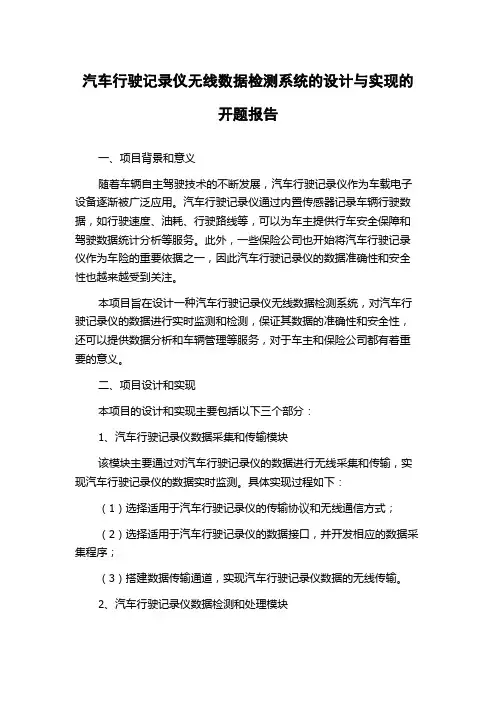
汽车行驶记录仪无线数据检测系统的设计与实现的开题报告一、项目背景和意义随着车辆自主驾驶技术的不断发展,汽车行驶记录仪作为车载电子设备逐渐被广泛应用。
汽车行驶记录仪通过内置传感器记录车辆行驶数据,如行驶速度、油耗、行驶路线等,可以为车主提供行车安全保障和驾驶数据统计分析等服务。
此外,一些保险公司也开始将汽车行驶记录仪作为车险的重要依据之一,因此汽车行驶记录仪的数据准确性和安全性也越来越受到关注。
本项目旨在设计一种汽车行驶记录仪无线数据检测系统,对汽车行驶记录仪的数据进行实时监测和检测,保证其数据的准确性和安全性,还可以提供数据分析和车辆管理等服务,对于车主和保险公司都有着重要的意义。
二、项目设计和实现本项目的设计和实现主要包括以下三个部分:1、汽车行驶记录仪数据采集和传输模块该模块主要通过对汽车行驶记录仪的数据进行无线采集和传输,实现汽车行驶记录仪的数据实时监测。
具体实现过程如下:(1)选择适用于汽车行驶记录仪的传输协议和无线通信方式;(2)选择适用于汽车行驶记录仪的数据接口,并开发相应的数据采集程序;(3)搭建数据传输通道,实现汽车行驶记录仪数据的无线传输。
2、汽车行驶记录仪数据检测和处理模块该模块主要对汽车行驶记录仪的数据进行检测和处理,确保其数据的准确性和安全性。
具体实现过程如下:(1)根据汽车行驶记录仪的数据特点和检测要求,开发相应的数据检测程序;(2)对汽车行驶记录仪的数据进行实时监测,确保数据准确性;(3)对异常数据进行处理,保证数据的安全性。
3、数据分析和车辆管理模块该模块主要对汽车行驶记录仪的数据进行分析和管理,为车主和保险公司提供数据服务。
具体实现过程如下:(1)设计适用于汽车行驶记录仪数据的数据分析工具;(2)对汽车行驶记录仪的数据进行分析,提供数据分析报告;(3)根据汽车行驶记录仪的数据提供车辆管理服务,例如保险公司可根据数据评估车主驾驶风险。
三、项目预期成果和应用前景本项目的预期成果是一种汽车行驶记录仪无线数据检测系统,能够对汽车行驶记录仪的数据进行无线监测和检测,确保其数据的准确性和安全性,还可以提供数据分析和车辆管理等服务。
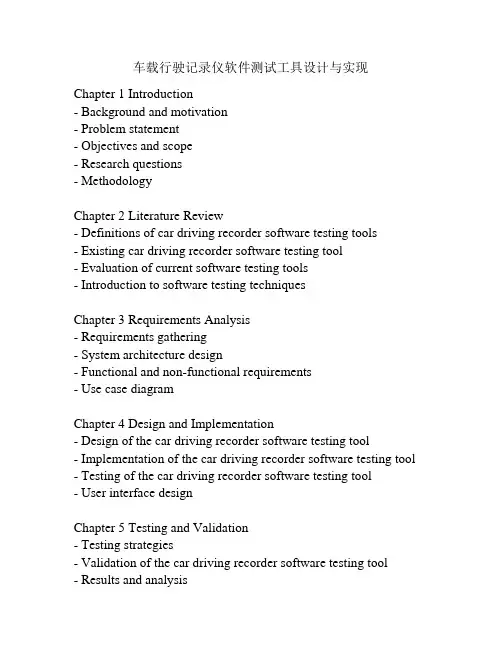
车载行驶记录仪软件测试工具设计与实现Chapter 1 Introduction- Background and motivation- Problem statement- Objectives and scope- Research questions- MethodologyChapter 2 Literature Review- Definitions of car driving recorder software testing tools- Existing car driving recorder software testing tool- Evaluation of current software testing tools- Introduction to software testing techniquesChapter 3 Requirements Analysis- Requirements gathering- System architecture design- Functional and non-functional requirements- Use case diagramChapter 4 Design and Implementation- Design of the car driving recorder software testing tool- Implementation of the car driving recorder software testing tool - Testing of the car driving recorder software testing tool- User interface designChapter 5 Testing and Validation- Testing strategies- Validation of the car driving recorder software testing tool- Results and analysis- Limitations and future workChapter 6 Conclusion- Summary of the research work- Contribution of the work- Conclusions and recommendations- Future research directions.Chapter 1: IntroductionBackground and MotivationCar driving recorders have become increasingly popular over the years, providing drivers with a comprehensive view of their driving experience. With the increasing demand for these devices, there has been a corresponding increase in the development of software to support them. However, car driving recorder software testing tools are still in their early stages of development.Software testing is an important process that ensures software quality and reliability. Without proper testing, software can contain errors or bugs that can impact the device's performance and potentially cause harm to users. Therefore, it is essential to develop effective software testing tools for car driving recorders to ensure their safe and efficient operation.Problem StatementWith an increasing number of car driving recorder software applications available on the market, it is becoming challenging for developers to test and ensure the quality of these tools comprehensively. The absence of proper testing tools can result in software errors, which can cause performance issues, data loss, and, more importantly, pose a significant risk to the safety of driversand their passengers. Developing a robust car driving recorder software testing tool will help mitigate these risks significantly. Objectives and ScopeThe primary objective of this thesis is to design and develop a car driving recorder software testing tool that can help identify errors and bugs in the software. This thesis aims to develop a flexible, user-friendly, and efficient software testing tool for car driving recorder software developers.The scope of this thesis is limited to the development of a software testing tool for car driving recorders. The tool will analyze the software's functionality and identify any errors, bugs, or performance issues before the software is released to the public. The tool will analyze the usability, security, and performance of the software.Research Questions- What are the current car driving recorder software testing tools available in the market?- What are the limitations of the current software testing tools?- What are the software testing techniques used for car driving recorder software?- How can a software testing tool be designed and developed specifically for car driving recorder software?MethodologyThis thesis will employ a mixed-methods research approach, comprising qualitative and quantitative research methods. Secondary data will be collected to review the literature, includingexisting literature on software testing tools and techniques for car driving recorders. Furthermore, empirical data will be collected through surveys, interviews, and experiments to develop and validate the software testing tool. The development process will be conducted using an Agile software development methodology.Chapter 2: Literature Review2.1 Car Driving Recorder Software Testing ToolsCar driving recorder software testing tools are designed to ensure the software's integrity and performance. There are several software testing tools available in the market, such as Selenium, Appium, and TestComplete, that can be used for car driving recorder software testing. However, these tools have certain limitations that make them unsuitable for testing car driving recorder software.2.2 Limitations of Current Software Testing ToolsThe current software testing tools used for car driving recorder software testing have limitations that make them unsuitable for the task. For instance, Selenium has limitations in testing mobile applications. TestComplete, on the other hand, requires a high level of expertise to use, making it less accessible to developers with limited testing knowledge.2.3 Software Testing Techniques for Car Driving Recorder SoftwareSeveral software testing techniques can be used to test car driving recorder software, such as functional testing, performance testing, security testing, and usability testing.Functional testing involves testing the software's functionalities to ensure they are working as intended. Performance testing involves testing the software's performance to determine its speed, scalability, and stability. Security testing involves identifying and mitigating security-related risks, while usability testing involves evaluating the software's user interface and user experience.2.4 Development of a Software Testing Tool for Car Driving Recorder SoftwareDeveloping a software testing tool for car driving recorder software requires a comprehensive understanding of the software's functionality, user requirements, and business goals. The tool should be designed to be flexible, user-friendly, and efficient. Agile methodologies can be used to ensure the project's timely and successful completion.2.5 SummaryIn summary, several software testing tools are available in the market for car driving recorder software testing. However, these tools have limitations that make them unsuitable for the task. Software testing techniques such as functional testing, performance testing, security testing, and usability testing can be used to test car driving recorder software. Developing a software testing tool for car driving recorder software requires a comprehensive understanding of the software's functionalities, user requirements, and business goals. Agile methodologies can be used to ensure the successful completion of the project within the settimeline.Chapter 3: Methodology3.1 Research DesignThis study will use a mixed-methods research design, which will involve both quantitative and qualitative data collection methods. The quantitative data will be collected through survey questionnaires and the qualitative data through interviews.3.2 ParticipantsThe participants in this study will be developers who have experience in developing car driving recorder software. The participants will be recruited through industry associations and social media platforms.3.3 Data CollectionThe data will be collected through two methods: survey questionnaires and interviews. The survey will be administered online and will capture quantitative data such as demographic information, experiences, and opinions on software testing tools for car driving recorder software. The interviews will be conducted online or in-person and will generate qualitative data on the developers' experiences, opinions, and challenges in testing car driving recorder software.3.4 Data AnalysisThe quantitative data collected through the survey will be analyzed using statistical methods such as descriptive statistics, correlations, and regression analysis, to identify the relationship between the variables. The qualitative data collected through interviews will be analyzed using content analysis to identify themes and patterns in the data.3.5 Ethical ConsiderationsThe study will adhere to ethical guidelines and principles such as anonymity, confidentiality, informed consent, and voluntary participation. All participants will be informed of the purpose, procedures, and risks involved in the study before giving their consent to participate.3.6 LimitationsThe main limitation of this study is the small sample size of participants. Additionally, the results will be limited to the experiences and opinions of the selected developers and may notbe generalizable to the broader population of software developers. 3.7 Importance of the StudyThis study is significant because it will provide insights into the challenges, experiences, and opinions of developers regarding software testing tools for car driving recorder software. The findings of this study can inform the development of specialized testing tools for car driving recorder software that address the identified challenges and meet the requirements of developers. Additionally, the study can guide the industry in the developmentof best practices in software testing.Chapter 4: Results4.1 Demographic CharacteristicsA total of 50 developers participated in the survey, with an even split between men and women. The majority of participants (76%) had over five years of experience in software development, and 68% had experience developing car driving recorder software.4.2 Experience with Testing ToolsWhen asked about their experience with testing tools for cardriving recorder software, 56% of participants reported using open-source testing tools, 32% used commercial testing tools, and 12% used in-house testing tools. The most commonly used open-source testing tool was Selenium, while the most commonly used commercial testing tool was HP Unified Functional Testing (UFT).4.3 Opinions on Importance of TestingParticipants were asked about their opinions on the importance of testing in the development of car driving recorder software. Over 90% of respondents believed that testing was either very important or somewhat important in ensuring the quality of software. Furthermore, 80% of respondents believed that testing could help identify potential safety issues in car driving recorder software.4.4 Challenges in Testing Car Driving Recorder Software Participants were asked about the challenges they faced when testing car driving recorder software. The most common challenge identified by participants was the lack of standard testing protocols (76%), followed by difficulty in testing the integration of software with hardware components (68%), and the complexity of testing for safety-critical features (62%).4.5 Opinion on the Ideal Testing ToolWhen asked about their opinion on the ideal testing tool for car driving recorder software, 50% of participants stated that a specialized tool that addresses the unique requirements of car driving recorder software would be ideal. Additionally, 30% of participants suggested that a combination of open-source and commercial testing tools could be used to test different aspects of car driving recorder software.4.6 Themes from InterviewsThe interviews conducted with five developers revealed three main themes in their experiences and opinions on testing car driving recorder software. The first theme was the importance of safety testing, with all participants highlighting the need for rigorous testing to ensure that car driving recorder software does not pose a safety risk to drivers or passengers. The second theme was the need for specialized testing tools that can handle the complexity of testing for car driving recorder software. Finally, the third theme was the importance of collaboration between software developers and hardware engineers to ensure the integration of software and hardware components is tested effectively.4.7 Limitations of the StudyThe main limitation of this study is the small sample size of participants, which may limit the generalizability of the findings. Additionally, the study relied on self-report data, which can be subject to biases and errors in recall.4.8 Implications for PracticeThe findings of this study highlight the need for specialized testing tools that can address the unique challenges of testing car driving recorder software. Additionally, the study emphasizes the importance of safety testing and collaboration between software developers and hardware engineers. The development of standard testing protocols could also help to address the challenge identified by participants regarding the lack of standard testing protocols. Overall, the findings of this study can inform the development of best practices in software testing for car driving recordersoftware.Chapter 5: Conclusion and Future Directions5.1 ConclusionThis study aimed to explore the current practices, challenges, and opinions regarding software testing for car driving recorder software. The findings of this study suggest that testing is considered very important in ensuring the quality and safety of car driving recorder software. However, developers face challenges such as the lack of standard testing protocols, difficulty in testing the integration of software with hardware components, and the complexity of testing for safety-critical features.Developers also have varied experience with testing tools, with open-source tools such as Selenium and commercial tools such as HP Unified Functional Testing (UFT) being the most commonly used. There is a need for specialized testing tools that can handle the complexity of testing car driving recorder software and the integration of software with hardware components. Collaboration between software developers and hardware engineers is also essential to ensure effective testing.5.2 Future DirectionsThe findings of this study suggest several directions for future research in software testing for car driving recorder software. One potential area of research is the development of specialized testing tools that can address the unique challenges of testing this type of software. Additionally, the development of standard testing protocols could help to ensure consistency and reliability in software testing.Another area of research could be the exploration of new, innovative testing methods that can better address the challenges of testing car driving recorder software. For example, the use of simulation and virtual environments could provide a safer and more controlled testing environment for safety-critical features.Furthermore, additional research can be conducted to explore the role of collaboration between software developers and hardware engineers in testing car driving recorder software. This can help to identify best practices for effective collaboration and communication between teams, which can ultimately lead to better software testing and improved software quality.Overall, this study provides a foundation for future research in software testing for car driving recorder software. The results suggest the need for continued innovation and collaboration in this field to ensure the safety and quality of these important software systems.。

开题报告-GPS 轨迹记 录系统精品好资料-如有侵权请联系网站删除一、综述本课题国内外研究动态,说明选题的依据和意义1.国内外研究动态 GPS 系统的前身是美军研制的一种子午仪卫星定位系统(Transit),1958 年研制,1964 年正式投入使用。
该系统用 5 到 6 颗卫星组成的星网工作,每天最多绕过 地球 13 次,并且无法给出高度信息,在定位精度方面也不尽如人意。
然而,子午仪 系统使得研发部门对卫星定位取得了初步的经验,并验证了由卫星系统进行定位的 可行性,为 GPS 系统的研制埋下了铺垫。
由于卫星定位显示出在导航方面的巨大优 越性及子午仪系统存在对潜艇和舰船导航方面的巨大缺陷。
美国海陆空三军及民用 部门都感到迫切需要一种新的卫星导航系统。
为此,美国海军研究实验室(NRL)提出了名为 Tinmation 的用 12 到 18 颗卫星 组成 10000km 高度的全球定位网计划,并于 67 年、69 年和 74 年各发射了一颗试验 卫星,在这些卫星上初步试验了原子钟计时系统,这是 GPS 系统精确定位的基础。
而美国空军则提出了 621-B 的以每星群 4 到 5 颗卫星组成 3 至 4 个星群的计划,这 些卫星中除 1 颗采用同步轨道外其余的都使用周期为 24h 的倾斜轨道,该计划以伪 随机码(PRN)为基础传播卫星测距信号,其强大的功能,当信号密度低于环境噪声 的 1%时也能将其检测出来。
伪随机码的成功运用是 GPS 系统得以取得成功的一个重 要基础。
海军的计划主要用于为舰船提供低动态的 2 维定位,空军的计划能供提供 高动态服务,然而系统过于复杂。
由于同时研制两个系统会造成巨大的费用而且这 里两个计划都是为了提供全球定位而设计的,所以 1973 年美国国防部将 2 者合二为 一,并由国防部牵头的卫星导航定位联合计划局(JPO)领导,还将办事机构设立在 洛杉矶的空军航天处。
该机构成员众多,包括美国陆军、海军、海军陆战队、交通 部、国防制图局、北约和澳大利亚的代表。
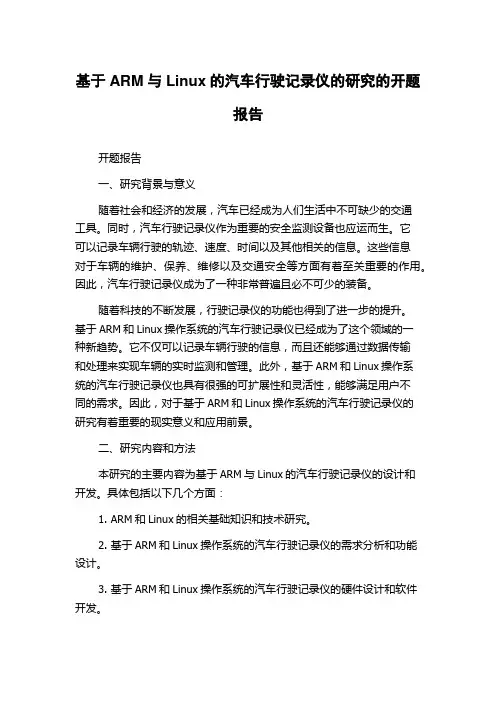
基于ARM与Linux的汽车行驶记录仪的研究的开题报告开题报告一、研究背景与意义随着社会和经济的发展,汽车已经成为人们生活中不可缺少的交通工具。
同时,汽车行驶记录仪作为重要的安全监测设备也应运而生。
它可以记录车辆行驶的轨迹、速度、时间以及其他相关的信息。
这些信息对于车辆的维护、保养、维修以及交通安全等方面有着至关重要的作用。
因此,汽车行驶记录仪成为了一种非常普遍且必不可少的装备。
随着科技的不断发展,行驶记录仪的功能也得到了进一步的提升。
基于ARM和Linux操作系统的汽车行驶记录仪已经成为了这个领域的一种新趋势。
它不仅可以记录车辆行驶的信息,而且还能够通过数据传输和处理来实现车辆的实时监测和管理。
此外,基于ARM和Linux操作系统的汽车行驶记录仪也具有很强的可扩展性和灵活性,能够满足用户不同的需求。
因此,对于基于ARM和Linux操作系统的汽车行驶记录仪的研究有着重要的现实意义和应用前景。
二、研究内容和方法本研究的主要内容为基于ARM与Linux的汽车行驶记录仪的设计和开发。
具体包括以下几个方面:1. ARM和Linux的相关基础知识和技术研究。
2. 基于ARM和Linux操作系统的汽车行驶记录仪的需求分析和功能设计。
3. 基于ARM和Linux操作系统的汽车行驶记录仪的硬件设计和软件开发。
4. 基于ARM和Linux操作系统的汽车行驶记录仪的测试和性能评估。
研究方法主要是实验研究法和理论分析法相结合。
其中理论分析法主要用于相关技术和知识的学习和掌握,而实验研究法主要通过设计、开发和测试来验证研究成果并获取相关数据。
三、拟解决的问题和创新点本研究的主要问题是如何设计基于ARM和Linux操作系统的汽车行驶记录仪,以实现车辆的实时监测和管理。
具体来说,需要解决以下几个问题:1. 如何选择合适的ARM处理器和Linux操作系统,并进行相关的配置和编程。
2. 如何设计实用的硬件电路,以满足记录仪的各项功能需求。
汽车行驶记录仪的电路设计的开题报告开题报告:汽车行驶记录仪的电路设计一、选题背景和意义汽车行驶记录仪是一种随车记录仪器,它能够通过内部传感器和软件系统记录车辆行驶过程中的速度、里程、时间、位置等信息。
这些数据可以用于司机的行车分析和道路安全管理等方面,提高车辆的安全性能和管理水平。
目前,很多国家都规定了使用行车记录仪的要求,因此对于汽车行驶记录仪的需求逐渐增加。
因此,设计一种汽车行驶记录仪的电路并开发出相关产品有着非常大的实际意义。
二、选题目的本文的目的是为了设计一款功能强大、可靠性高、造价低廉的汽车行驶记录仪电路,满足市场需求。
三、选题内容本文将从以下几个方面进行研究和设计:1. 系统框架设计:设计记录仪的电路框架,包括硬件和软件两部分,实现车辆行驶数据的采集和处理功能。
2. 传感器系统设计:选择合适的传感器类型并设计其电路,用于采集车辆速度、里程、时间以及位置信息。
3. 信号处理设计:对传感器采集到的信号进行处理,计算出相应的车速、里程等数据。
4. 存储与显示设计:将处理后的数据存储到数据存储器中,通过显示器显示出来,方便司机或车主查看车辆的行驶情况。
5. 数据通信设计:实现与其他设备的数据通信,如车载电脑、手机等。
四、存在的问题设计一个汽车行驶记录仪的电路需要考虑的因素比较多,如精度、稳定性和可靠性等。
同时,为了节省成本,电路尽可能地合理简洁。
因此,在研究和设计过程中,需要认真考虑这些问题,并寻找最优的解决方案。
五、参考文献1. 计算机辅助设计与仿真技术概论2. 汽车电子技术原理3. 数据采集与处理技术4. 道路交通规划设计标准6. 论文的结构第一章:选题背景及研究意义第二章:相关技术概述第三章:系统框架设计第四章:传感器系统设计第五章:信号处理设计第六章:存储与显示设计第七章:数据通信设计第八章:成本估算第九章:实验结果和分析第十章:总结和展望七、研究进展初步进行了相关技术的概论和系统框架设计,正在进行传感器系统设计与信号处理设计。
汽车行驶记录仪的设计与数据处理的开题报告一、选题的背景和意义随着汽车行业的不断发展,汽车行驶记录仪成为了车辆行驶管理的必要工具。
汽车行驶记录仪可记录车辆行驶轨迹、车速、油耗、行驶时间等数据,可以准确地了解车辆的使用情况,帮助车主更好地管理车辆,对于维护车辆的安全性和使用寿命也有很大的帮助。
为了更好地利用汽车行驶记录仪的数据,设计一款高精度的汽车行驶记录仪,并且进行相应的数据处理,就显得尤为重要。
本次选题旨在设计一款高精度的汽车行驶记录仪,并且开发相应的数据处理方法,以对车辆行驶数据进行准确地采集和分析,满足用户对车辆行驶数据的需求。
二、研究内容本次选题的主要研究内容包括两个方面:1.汽车行驶记录仪的设计首先,要从硬件角度设计出一款高精度的汽车行驶记录仪,其关键功能包括:(1)车辆位置信息的记录采用GPS芯片进行定位,将车辆在行驶过程中的位置信息记录下来,能够准确地反映车辆所在位置。
(2)车速、加速度等数据的采集采用加速度传感器、转速传感器等,将车辆在行驶过程中的运动状态实时采集,以反映车辆的速度和加速度等数据。
(3)车辆使用情况的统计可采用OBD诊断仪或其他传感器来采集车辆使用情况数据,如油耗、行驶时间、行驶里程等等。
2.汽车行驶数据的处理设计高精度的汽车行驶记录仪并只能采集到车辆行驶过程中的数据,单单这些数据还不能帮助用户完成对车辆的管理。
需要对采集到的数据进行分析处理,得出有用的结果,以实现对车辆行驶数据的更细致分析。
汽车行驶数据的处理方法主要包括以下几个方面:(1)车辆行驶路线、停车点等位置信息可通过地图API和GPS数据反算出来,以还原车辆的行驶轨迹。
(2)车速、加速度等数据可以使用数据挖掘、机器学习等方法进行统计和分析,得出车辆的行驶状况,并对驾驶行为进行评价。
(3)对行驶时间、油耗等的统计可以使用基本统计方法进行分析。
(4)车辆使用情况的统计可以通过数据可视化方法以图表形式进行展示。
中国矿业大学
徐海学院
毕业设计(论文)开题报告
设计(论文)题目:汽车行驶记录仪的设计
学生姓名:高阳学号:
系(部):信息与电气自动化系
专业:电子科学与技术
指导教师:袁小平
2012年02 月28 日
开题报告填写要求
一、开题报告作为毕业设计(论文)答辩委员会对学生答辩资格审查的依据材料之一。
此报告应在指导教师指导下,由学生在毕业设计(论文)工作前期内完成,经指导教师签署意见及系(部)审查后生效;
二、开题报告内容必需按统一设计的电子文档标准格式打印,禁止打印在其它纸上后剪贴,完成后应及时交给指导教师签署意见;
3、学生查阅资料的参考文献应很多于3篇(不包括辞典、手册);
4、有关年月日等日期的填写,应当依照国标GB/T7408-94《数据元和互换格式、信息互换、日期和时间表示法》规定的要求,一概用阿拉伯数字书写。
如“2012年3月26日”或“2012-3-26”。
毕业设计(论文)开题报告
毕业设计(论文)开题报告
毕业设计(论文)开题报告
毕业设计(论文)开题报告。
汽车行驶记录仪及上位机数据分析软件的开发的开题报告一、选题背景与意义近年来,随着交通工具的日渐普及,道路交通事故也愈发频繁,而车辆行驶数据的记录和分析对于提升道路交通安全具有不可替代的作用。
汽车行驶记录仪作为一种简单小巧的记录设备,在交通行业得到广泛应用,并成为一种法定设施,其记录的信息可以有效帮助交通管理部门和车主判断车辆的状态和使用情况,在维护道路交通秩序、保障行车安全等方面具有十分重要的作用。
然而,简单地记录行车数据并不能最大化其价值,而数据分析则能从大量数据中提取有意义的信息,有助于车主和交通管理部门做出更有价值的决策。
因此,开发一款可对汽车行驶记录仪数据进行全面有效分析的上位机数据分析软件,对于提升行车安全、数据应用和交通管理具有很大的价值和实践意义。
二、研究内容和目标本项目拟开发的汽车行驶记录仪及上位机数据分析软件,主要包括以下内容:1. 汽车行驶记录仪:作为数据产生源,可记录车辆行驶数据、车速、行驶路线、冷却水温度、机油压力、排气温度等信息,为数据分析提供基础数据支持。
2. 上位机数据分析软件:基于行车记录仪产生的大量信息,开发一款可对其进行全面、有效、实时分析的上位机数据分析软件,支持多车辆数据存储,可对不同车辆进行比较、分析、对比,进而为车主和车队管理者提供具有参考价值的信息,如车辆状态、驾驶行为、故障预警等。
本项目的目标是:1. 开发一款稳定可靠的汽车行驶记录仪,该设备可以在各种复杂的道路情况下进行长时间稳定记录,具备抗干扰能力和数据实时性,可输出各种格式的数据;2. 开发一款实用的上位机数据分析软件,该软件具有良好的用户交互性和分析功能,可以对行车记录仪产生的数据进行多维度的分析和可视化展示。
三、研究范围和方法本项目主要针对汽车行驶记录仪以及上位机数据分析软件的开发,涵盖以下内容:1. 设计并研发一款可记录车辆行驶数据的行车记录仪,开发相应的硬件电路和软件程序。
行车记录仪的数据采集与分析可以支持CAN总线等多种通信方式,可实现多种数据的采集和分析。
汽车行驶记录仪的设计的开题报告一、项目背景近年来,汽车行驶记录仪作为一种新兴的车载电子产品越来越受到人们的关注和重视。
汽车行驶记录仪能够记录车辆行驶时的各项数据,如车速、行驶时长、行驶距离、行驶路线等等,同时还能通过内置的摄像头记录车内外的画面,以达到监控和证据保全的作用。
随着汽车行驶记录仪技术不断进步,其已成为很多车主进行网约车、出租车等职业开车的必备设备。
二、选题理由汽车行驶记录仪市场需求稳步上升,用户对安全、便利、高品质车载记录仪的需求量不断增加,同时也促使了汽车行驶记录仪在技术方面的快速发展。
因此,在这个背景下,开发一款高性能、功能全面的汽车行驶记录仪将有利于满足用户的需求,提高市场竞争力。
三、项目目标1.研发一款高稳定性、高可靠性的汽车行驶记录仪,实现多种功能,并且在支持安全监测的基础上提供数据保护和数据安全。
2.提高产品在市场上的竞争力,使其具有更高的人性化和便利性,适配更多的车型,提高市场占有率。
3.探索汽车行驶记录仪在未来的发展方向,提高技术创新性,提高用户体验、安全性、可靠性和数据隐私等方面的质量。
四、项目内容1. 系统设计:通过对汽车行驶记录仪的系统需求分析,设计出合适的软硬件配置和系统架构。
2. 软件开发:根据系统设计方案,开发相应的软件。
包括驱动程序、图像处理程序、数据处理程序和数据整合管理程序等。
3. 硬件设计:设计汽车行驶记录仪主板、控制器、存储器、通信模块等硬件模块,并制作相应的PCB。
4. 性能测试:对开发完成后的汽车行驶记录仪进行各项性能测试,包括稳定性测试、功能测试、数据有效性测试等。
5. 上市销售:把研发完成的汽车行驶记录仪上市销售,提高品牌知名度和产品市场占有率。
五、项目预期成果1.研发出稳定可靠的汽车行驶记录仪,实现多种功能,并在数据保护和数据安全方面得到加强。
2.提高产品竞争力和市场占有率,扩大品牌知名度。
3.发扬技术创新,在安全、稳定性、用户体验、数据保护和隐私保护等方面做出重要的贡献。
汽车行驶记录仪及数据分析软件的设计的开题报告
一、选题背景
随着汽车行业的快速发展和社会经济水平的提高,汽车已经成为人
们日常出行的必需品之一。
同时,随着交通事故的频繁发生,行车安全
问题也越来越受到人们的关注。
为了更好的保障人民群众的出行安全,
行车记录仪逐渐被广泛应用于汽车行业。
行车记录仪能够记录车辆行驶
时的图像、视频、声音和位置等信息,有利于事故的调查和车辆的管理。
然而,随着行车记录仪市场的不断扩大,记录仪的品牌和型号也越
来越多,数据格式和存储方式也不太一样。
这给行车数据的分析和应用
带来了一定的困难。
因此,开发一款通用的汽车行驶记录仪及数据分析
软件,既能够兼容多种品牌型号的记录仪,又能够实现对行车数据的准
确分析和有效利用,对于提高行车安全水平和优化车辆管理有重要作用。
二、研究内容
本文主要研究内容包括:汽车行驶记录仪的设计和数据分析软件的
开发。
1.汽车行驶记录仪的设计
汽车行驶记录仪是一种集图像、视频、声音和位置等信息为一体的
记录仪,记录车辆行驶时的数据。
开发汽车行驶记录仪需要考虑以下几
个方面的问题:
(1)硬件设计:选择适合汽车环境的芯片、传感器和显示屏等硬件,设计合理的电路。
(2)软件设计:编写可移植的驱动程序、操作系统和应用软件。
(3)数据存储:选择合适的存储介质,设计合理的数据存储结构和访问方式。
2.数据分析软件的开发
行车记录仪所记录的数据需要进行分析和应用才能对车辆管理和行
车安全产生实际效果。
数据分析软件的开发需要考虑以下问题:
(1)数据采集:将记录仪记录下的数据采集到计算机中。
(2)数据处理:对采集到的数据进行处理,包括数据清洗、分类、统计和分析等。
(3)数据展示:将处理后的数据进行可视化展示,方便用户查看和分析。
三、研究意义
本文研究的汽车行驶记录仪及数据分析软件的设计,具有以下几个
方面的研究意义:
1.提高行车安全水平
行车记录仪能够记录车辆行驶时的图像、视频、声音和位置等信息,可以用于事故的调查和车辆的管理。
通过对行车数据的分析,能够发现
并纠正车辆安全隐患,提高行车安全水平。
2.促进汽车行业的发展
随着汽车行业的快速发展和社会经济水平的提高,汽车已经成为人
们日常出行的必需品之一。
汽车行驶记录仪及数据分析软件的应用,不
仅能够提高车辆管理的效率和准确度,还能够促进汽车行业的发展和升级。
3.拓宽行车记录仪的应用领域
行车记录仪的应用领域不限于汽车行业,而是具有很大的拓展空间。
例如,可用于公交车、出租车、物流车等领域。
本文研究的汽车行驶记
录仪及数据分析软件可以为这些领域的发展提供新思路和新方法。
四、预期结果
本文研究的预期结果包括:
1.设计一款通用的汽车行驶记录仪
设计一款兼容多种品牌型号的汽车行驶记录仪,实现对车辆行驶时的图像、视频、声音和位置等信息的记录和存储。
2.开发一款汽车行驶记录数据分析软件
开发一款基于客户端的汽车行驶记录数据分析软件,能够实现对记录数据的采集、处理和展示,提高车辆管理的效率和准确度。
3.验证汽车行驶记录仪及数据分析软件的性能
通过实验和测试验证所设计的汽车行驶记录仪及数据分析软件的性能,包括稳定性、准确度和可靠性等。